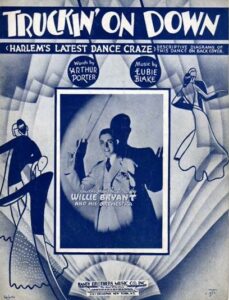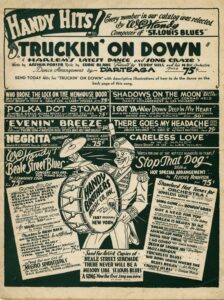YOUR DAILY DOSE OF EUBIE!!!
In the mid-‘30s, Eubie took a job in the offices of music publisher W. C. Handy, working as an arranger as well as weeding through the submissions of would-be songwriters. He may have crossed paths with Handy’s secretary, Marion Tyler, who would later become Eubie’s second wife, although Blake did not mention meeting her in the offices. Handy may have offered Eubie a part-time position and an office out of sympathy for the struggling composer, whose performing and composing careers had both fizzled out due to the Depression. While Eubie’s band occasionally performed in the New York area through 1936, take home pay was greatly diminished and it was becoming increasingly difficult to support a 9 or 10 piece unit.

Eubie didn’t give up on composing entirely and drew on Handy’s friendship (and printing press) to try to get back onto the Hit Parade. In 1935, Handy published a new dance tune by Eubie, “Truckin’ On Down,” to cash in on the “truckin’” dance craze, with lyrics by Arthur Porter. Blake crafted a typically singable tune that was traded back and forth between the left and right hands in the song’s introduction, leading into a slightly swinging verse. After its initial publication, bandleader Teddy Hill was “cut in” to the royalties to encourage him to record it. Although it sold over 1000 copies, the advance to Hill ate up all of Eubie’s royalties.

Handy published another pop number by Eubie, “It Ain’t Being Done No More” and the light classical piece “Blue Thoughts,” which sold a paltry 38 copies in its first year. Like most of Blake’s works, “Blue Thoughts” featured several memorable melodic themes, but was dressed in the then-current harmonic wrappings of “advanced” music (similar to the work being done by William Grant Still and James P. Johnson in a classical style).